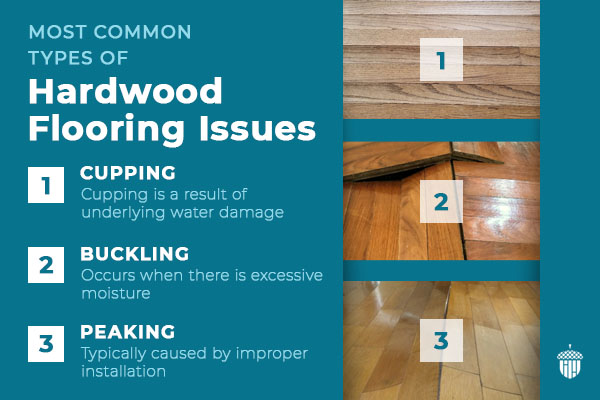
Dealing with buckling wood floors can be a frustrating experience, impacting both the aesthetics and functionality of a home. The unsightly warping and gaps can make a room feel less inviting and can even lead to safety concerns. Buckling floors are typically a symptom of underlying issues, often related to moisture or structural problems. This article provides a comprehensive guide to understanding the causes, prevention, and effective repair strategies for this common flooring issue. We will explore the different causes of floor buckling, discuss effective preventative measures, and detail various repair techniques, including subfloor replacement and floor leveling. We will also offer a step-by-step approach to assist you in tackling this problem.
Understanding the Causes of Buckling Wood Floors
Moisture Issues:
Excessive moisture is a primary culprit behind warped or buckled wooden floors. High humidity can cause the wood to expand, while sudden temperature fluctuations or water damage can lead to shrinking and warping. This issue can often arise in basements or areas with poor ventilation.
Structural Problems:
Underlying structural issues, like uneven or inadequate subfloors, can also contribute to buckling. If the subfloor is not level or stable, the wood planks above will be susceptible to warping and bowing. Uneven settling of the house is another possibility.
Improper Installation:
Sometimes, improper installation techniques are to blame. Missing or poorly secured support beams, inadequate nailing techniques, or improper spacing between planks can result in eventual buckling.
Pest Infestation:
Termites or other wood-boring insects can weaken the structural integrity of the wood, eventually leading to buckling. Signs of pest damage, like hollowed-out areas, are important to look out for.
Preventative Measures for Buckling Wood Floors
Maintaining Proper Humidity Levels:
Regularly monitoring and maintaining the appropriate humidity levels in your home can prevent the expansion and contraction of the wood, thus reducing the risk of warping. Dehumidifiers can be helpful in areas prone to high humidity.
Addressing Structural Issues:
If the subfloor is uneven or damaged, repairing the subfloor or structural issues is crucial. Consider professional assessment to determine the needed repairs.
Proper Flooring Installation:
Ensure proper flooring installation practices, including using appropriate nails, securing the planks effectively and providing proper spacing. Hire qualified contractors for this.
Pest Control:
Implementing a consistent pest control strategy is essential to prevent wood-boring pests from damaging wooden floors.
Repairing Buckled Wood Floors
Subfloor Repair and Replacement:
Often the most effective solution involves repairing or replacing the subfloor. Replacing the subfloor with a level, stable subfloor is usually the most effective solution to prevent future buckling. The subfloor must be appropriately supported and level. Consider using plywood or OSB as replacements.
Floor Leveling:
When subfloor replacement isn’t feasible, floor leveling techniques can be used to restore the level surface of the flooring. This process may involve using shims or leveling compounds to correct unevenness.
Plank Replacement:
Replacing individual warped planks is an option for less severe buckling. Ensure that the replacement planks match the existing ones in terms of species and dimensions for optimal aesthetic appeal.
Professional Consultation:
Consulting with a professional flooring contractor is always recommended, as they can assess the extent of the damage and recommend the best approach for repair. Professional contractors have the knowledge, tools, and expertise to execute the work properly.
Additional Considerations
Budgetary Constraints:
Repairs can involve significant costs, including professional labor, materials, and potentially subfloor replacements. It is important to understand these costs ahead of time to avoid budget shocks.
Time Commitment:
Repairing buckling floors can take time, depending on the extent of damage and the chosen repair method. Be prepared for a project that may require several days or even weeks to complete.
Environmental Conditions:
Consider the environmental conditions, particularly moisture levels, in the area when deciding on the best repairs. Ensuring appropriate ventilation can reduce the risk of future issues.
Materials and Tools:
Acquire necessary tools, including those for working with the floor and other materials for repairs. This will enable a more streamlined process.
Selecting the Right Repair Solution
Assessing the Extent of Damage:
Thoroughly inspect the affected area to understand the level of damage, from simple warping to significant structural damage. Knowing the extent of the buckling is critical.
Evaluating Your Budget:
Factor in the costs of materials, labor, and potential subfloor replacement. Different solutions will lead to different financial commitments.
Considering Time Constraints:
Determine how much time you’re willing to dedicate to the project. Assess if you have the required skills and time for self-repair or if seeking professional help is more suitable.
Professional Expertise:
Understanding the importance of professional help for complex repairs or severe damages is paramount for safe and quality work.
In conclusion, dealing with buckling wood floors requires a systematic approach. By understanding the root causes, employing appropriate preventative measures, and choosing the right repair techniques, homeowners can successfully restore their floors to a functional and aesthetically pleasing state. If you’re still unsure about any aspects of the repair process, it’s highly recommended that you consult with a qualified flooring professional. They can provide a personalized assessment of your situation and recommend the most suitable solution for your specific needs.